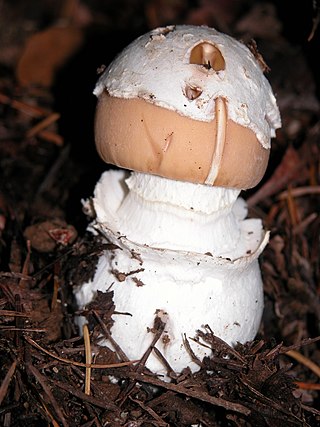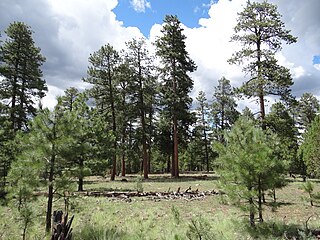
Pinus jeffreyi, also known as Jeffrey pine, Jeffrey's pine, yellow pine and black pine, is a North American pine tree. It is mainly found in California, but also in the westernmost part of Nevada, southwestern Oregon, and northern Baja California. It is named in honor of its botanist documenter John Jeffrey.

Pinus ponderosa, commonly known as the ponderosa pine, bull pine, blackjack pine, western yellow-pine, or filipinus pine, is a very large pine tree species of variable habitat native to mountainous regions of western North America. It is the most widely distributed pine species in North America.

Pacific Pines State Park is a 10-acre (4.0 ha) Washington state park on the Long Beach Peninsula, just north of Ocean Park. From the main parking area, there is a narrow, sandy footpath that leads through a grove of Pacific Ponderosa pine trees to the beach. The park offers picnicking, beachcombing, fishing, clamming, and crabbing.

The Xyelidae are a comparatively species-poor family of sawflies, comprising about 80 extant species in five genera worldwide, and is the only family in the superfamily Xyeloidea. The fossil record of the family is extensive, comprising more than 120 species and including the oldest fossil Hymenoptera species dating back to the Triassic, between 245 and 208 million years ago. Xyelidae are to be regarded as living fossils since they represent one of the oldest lineages of insects and include still extant forms.

The Turnbull National Wildlife Refuge is located six miles (10 km) south of Cheney, Washington, on the eastern edge of the Columbia Basin in Spokane County in northeastern Washington. Turnbull NWR encompasses more than 23,000 acres (9,300 ha) of the Channeled Scablands. The ecosystem that predominates the refuge is unique within the National Wildlife Refuge System and has characteristics that distinguish it from natural reserves worldwide. The combination of basalt outcrops, channeled canyons, and ponderosa pine forests infused in a diverse landscape of over 130 marshes, wetlands, and lakes creates an environment of aesthetic beauty as well as high quality wildlife habitat. The refuge is named for Cyrus Turnbull who lived on the site in the 1880s.

The Blue Mountains ecoregion is a Level III ecoregion designated by the United States Environmental Protection Agency (EPA) in the Pacific Northwest, mainly in the state of Oregon, with small areas over the state border in Idaho and southeastern Washington. It is also contiguous with the World Wildlife Fund's Blue Mountain forests ecoregion.

The North Central Rockies forests is a temperate coniferous forest ecoregion of Canada and the United States. This region overlaps in large part with the North American inland temperate rainforest and gets more rain on average than the South Central Rockies forests and is notable for containing the only inland populations of many species from the Pacific coast.

Amanita breckonii is a species of agaric fungus in the genus Amanita. It is known from California and Washington, where it associates with Monterey pine, ponderosa pine, and spruce. The species was described as new to science in 1982 by mycologists Harry Delbert Thiers and Joseph Ammirati. The holotype specimen was collected in 1966 on the campus of San Francisco State University by then graduate student Gary Breckon, for whom the species is named.

Ponderosa pine forest is a plant association and plant community dominated by ponderosa pine and found in western North America. It is found from the British Columbia to Durango, Mexico. In the south and east, ponderosa pine forest is the climax forest, while in the more northern part of its range, it can transition to Douglas-fir or grand fir, or white fir forests. Understory species depends on location. Fire suppression has led to insect outbreaks in ponderosa pine forests.

Xyela is a genus of sawflies, belonging to the family Xyelidae.
Xyela alpigena is a species of sawfly in the genus Xyela and is endemic to North America. It can be found from Quebec to Maryland and Maine, and west to Utah and New Mexico. The host plant for the larvae is Pinus strobus.
Xyela bakeri is a species of sawfly in the genus Xyela and is endemic to North America. It can be found from Quebec to Florida, and west to British Columbia and California. It has widespread hosts for its larvae, including Pinus elliottii, P. palustris, P. ponderosa, P. sabiniana, and P. virginiana.
Xyela californica is a species of sawfly in the genus Xyela that is endemic to California.
Xyela cheloma is a species of sawfly in the genus Xyela that is endemic to North America. It can be found in Idaho, Nevada, British Columbia, Washington, and Oregon. The host for the larvae is Pinus ponderosa.
Xyela concava is a species of sawfly in the genus Xyela that is endemic to North America. It can be found in Utah, Nevada, and California. The host for the larvae is Pinus monophylla and P. ponderosa.
Xyela deserti is a species of sawfly in the genus Xyela that is endemic to North America. It can be found in Nevada and California. The host for the larvae is Pinus monophylla.
Xyela dodgei is a species of sawfly in the genus Xyela that is endemic to Florida.
Xyela gallicaulis is a species of sawfly in the genus Xyela that is endemic to North America. It can be found in Virginia and Georgia. The larva feeds inside shoots and forms galls in its host which include: Pinus echinata, P. elliottii, and P. taeda.
Xyela lunata is a species of sawfly in the genus Xyela that is endemic to California. The host for the larvae is Pinus coulteri and P. sabiniana.
Xyela minor is a species of sawfly in the genus Xyela that is endemic to North America. It can be found from Quebec to Florida, and west to British Columbia and California. The larvae have widespread hosts, including: Pinus coulteri, P. elliottii, P. muricata, P. palustris, P. ponderosa, P. sabiniana, P. taeda, and P. virginiana.









